Our homes are where we should feel the most secure. Unfortunately, the criminal element among us will not hesitate to violate our homes and steal not only our possessions, but our sense of safety and security. The good news is that there are measures that you can take to harden your home against intruders.
Think about home security in terms of layers. The first is the property around your house, second is the exterior of the building, and the last is the interior of the house. This will help you to compartmentalize the task of securing your home.
Related: Scare Them Off Or Shoot Them Dead?
The Property
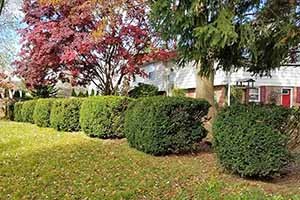 Walk around your house at night and think like a criminal. The goal is to identify any areas that would provide cover from view.
Walk around your house at night and think like a criminal. The goal is to identify any areas that would provide cover from view.
These could be areas that are poorly lit, bushes and shrubbery, or any objects or structures that criminals could hide behind.
Pay attention to the areas around windows and doors, as these are the most likely avenues of ingress.
Make notes of any areas that are dark or offer concealment and make a plan to remedy these situations. Aim to light up dark areas and, if possible cut back bushes and shrubbery to reduce or eliminate someone’s ability to hide.
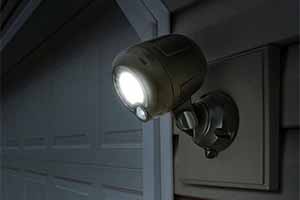 One of the best improvements you can install is motion-activated lights. These lights detect movement and turn on when motion is detected.
One of the best improvements you can install is motion-activated lights. These lights detect movement and turn on when motion is detected.
This has the advantage of illuminating and exposing any criminals that may be lurking around your home, and alerting you to possible trouble at the same time.
The entire perimeter of your house should be either illuminated or covered by motion lights.
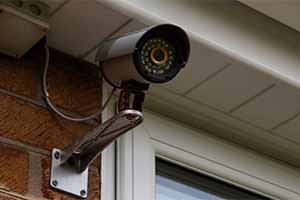 Cameras are also a great addition to your exterior security. They should be placed in such a way that no one can access any window or door without being filmed.
Cameras are also a great addition to your exterior security. They should be placed in such a way that no one can access any window or door without being filmed.
Security cameras are becoming increasingly inexpensive and do not require any special skills to install.
A good idea is to install cameras that will send alerts to your phone, if they detect motion. Some cameras also have two-way voice communication, which is handy for a main entry door. Being able to speak to someone without unlocking the door is another layer of security.
Installing a camera that covers the street will help to monitor suspicious activity in your neighborhood as well.
Related: Home Security Tips From an Ex-Burglar
The Exterior of the Building
 The first step is to either purchase a home security system, or acquire some signs and stickers to make it look like you have a security system.
The first step is to either purchase a home security system, or acquire some signs and stickers to make it look like you have a security system.
Posting a ‘Guard Dog on Duty’ sign is also a good idea, regardless of whether you have a dog or not.
Be sure to select a system that you can activate while you sleep, and always set the alarm when you go out or go to bed. Many potential burglars will avoid houses that they suspect of having a security system or dog.
Your front door is a very likely point of entry for a criminal, since they can approach the front entrance and ring the doorbell under the guise of salespeople, delivery people, or even law enforcement. This is a good way for them to determine if the home is occupied before attempting a break-in.
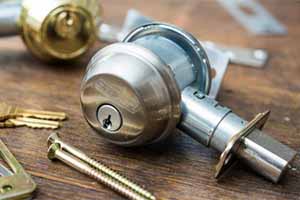 For all entry doors, your first step should be to upgrade the door hinges and deadbolt to the strongest that you can afford.
For all entry doors, your first step should be to upgrade the door hinges and deadbolt to the strongest that you can afford.
Installing a larger security strike plate with longer and larger screws will help to distribute the force of a kick.
Along with upgraded strike plates and hardware, the frame of the door should also be reinforced if possible. Avoid any electronic locks that use WIFI or Bluetooth technology, since they have the potential of being hacked.
A locking storm door is an addition that you should consider for your front door. These are doors of clear glass or mesh screen, which allow you to have a barrier between yourself and anyone who has come to your front door.
The advantage is that you can talk through this door without exposing yourself physically to a stranger. While the level of protection is minimal, it is enough to delay a home invader long enough to give you time to close and lock the front door.
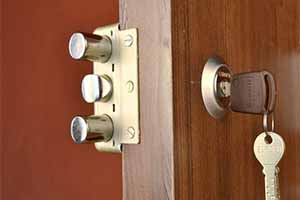 Install locks on the interior of every entry door that can only be locked and unlocked from the inside.
Install locks on the interior of every entry door that can only be locked and unlocked from the inside.
Again, make sure that you are purchasing the best ones that you can afford. Lock these locks before going to bed for the night.
Under no circumstances should you leave a key under the welcome mat, or in the flower pot. If you want to leave a key outside your house, hide it far away from the door, such as being buried in a backyard garden. Placing it in an old pill bottle and burying in a location you can easily remember is a far superior option.
Related: 10 Common Home Security Mistakes
Windows
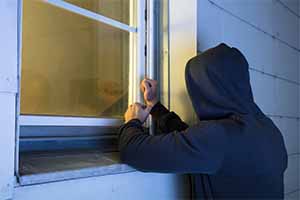 Glass windows are a major weak point in your home’s security, but it’s a feature of homes that we cannot live without.
Glass windows are a major weak point in your home’s security, but it’s a feature of homes that we cannot live without.
The best security for windows is steel bars. The problem is that steel bars rarely look good on a suburban home.
Another issue is that steel bars also prevent the occupants of the home from using those widows to escape the house in the event of an emergency such as a fire. If you decide to install bars, buy mounting hardware that is the strongest and largest that can be used.
An alternative to bars is a clear security window film, that can be applied to your windows. What this does is prevent the glass from shattering, much like a car windshield. While this method is only going to slow a criminal down, it will hopefully delay them long enough for the authorities to arrive.
These films are available in different thicknesses where the thicker the film, the greater the protection. Do this to all of your windows.
Every window that opens should have either a piece of wood or a device that prevents it from opening more than an inch or two.
Related: 10 Home Security Secrets from Venezuela
The Garage
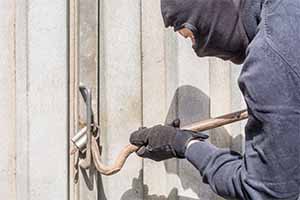 Your garage is a major weak point in your home’s security. If there is a door from the inside of the house to the garage, it must be secured the same as any other exterior door.
Your garage is a major weak point in your home’s security. If there is a door from the inside of the house to the garage, it must be secured the same as any other exterior door.
The actual garage door is not as stout as you may think and all it takes is to back into it with a vehicle, to destroy the door and render it useless.
Garage door openers are also prone to hacking, where a criminal will open your garage door by figuring out the code with software, then transmitting it to your opener.
You can buy sensors that connect to your WIFI network that will alert you when doors are opened. These are also good because you can use them to check if the garage door is closed, when you are away from home.
The Inside of Your Home
 The goal is to make your house appear to always be occupied, even when it is empty.
The goal is to make your house appear to always be occupied, even when it is empty.
If you have a dog, train it to bark every time someone knocks at the door or rings the doorbell. This will often convince a would-be thief that your house is not worth the risk.
Using timer switches for your exterior and some interior lights give the impression that someone is home, even if the house is empty. Some devices will simulate the glow of a TV, which is also set on timers to give the impression that someone is watching TV. Leaving a radio on in the house or the garage will also make burglars think that the building is occupied.
WIFI enabled sensors installed on doors and windows can send alerts to your phone, that a door or window has been opened. This will give you a heads up, even when you are not home, that someone is gaining entry.
Defense
 If someone has been determined enough to enter your home, despite all the passive countermeasures, then you need to have a plan to defend yourself and your family.
If someone has been determined enough to enter your home, despite all the passive countermeasures, then you need to have a plan to defend yourself and your family.
Escape is always the best option, your possessions are not worth dying for, so disengaging yourself and your family from the threat is the first option. Sometimes this is not possible and you are going to have to defend your family.
Self-defense is beyond the scope of this article, but you should know and understand the laws surrounding self-defense in your area. Also spend time running through scenarios in your head and coming up with plans for an adequate defense.
Your goal is to make your home unappealing for a criminal to attempt a break-in. Good lighting, cameras, guard dog signs, and security company signage should deter a large portion of the criminal element. For those who still want access, the upgraded entry doors and unbreakable windows will at least slow them down and alert you to the impending danger.
Finally, making the interior of your home always give the impression of being occupied, should also act as a significant deterrent. The major takeaway is to do whatever you can to not appear to be an easy victim.
You may also like:
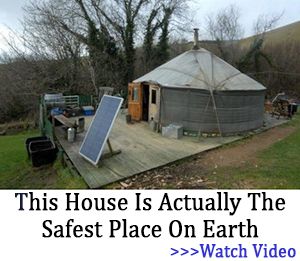 The Lost Superfoods: Book Review
The Lost Superfoods: Book Review
This Homemade Device Can Power Up Your Entire House 7 Days in a Row (Video)
Firearms for Emergency and SHTF Situations

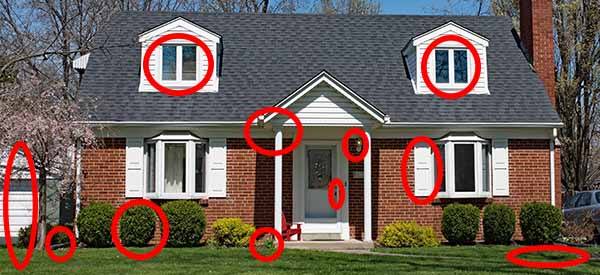













Location is key. We live on 75ac at the end of a small county road in a mountain valley that has only two entry roads. Both roads could easily be blocked in a SHTF situation by simply felling some trees across the road. This actually happened about 20 years ago when a freak snow storm hit, and one of the roads was blocked for months until the National Guard cleared it. The other was blocked for a week until neighbors got together and sawed our way out.
Our house is built back 1500′ from the end of the county road, (can’t even see it) and I built a gate at the entrance to our place. Installed two different driveway alerts (Dakota and Guardline) on the gate entrance and points along the drive. Motion light at the gate comes on when any movement happens at the gate. Two roving dogs sound off at most any movement on the place.
IF someone actually makes it to the house, it’s wide open. Haven’t locked the doors in 30 years. Come on in….there’s a Mossberg 500 waiting.
sounds like my dream home
I’d like to have a neighbor like you
@TnAndy: That is GREAT protection ONLY if they come via the driveway. If they come through the woods, well, you haven’t got a chance. I truly mean no disrespect or any such thing, but in a true SHTF scenario, many will NOT use roads, they will camp, live and loot via off road methods, and you won’t know they are on your property until they just walk through your unlocked door.
No one should assume that only one ‘normal’ way to get to your property or into your house will be used in a SHTF situation. You MUST plan for all possible ways and protect yourself and have backup plans if other weird or unusual ways are used against you.
I am not sure if the intent of this article was to harden your home against Billy Burglar or as a defense against an invasion by a gang after an EOTW event.
If it is the latter, I would remind readers that the walls of the average tract home are only designed to keep out bad weather. I can’t speak to building codes in other states or even the cold weather regions of the PDRK, but in SoCal, most homes don’t even have insulation between the inner wall and the outer wall. A 9 mm pistol bullet, now the most common caliber preferred by bad guys will easily penetrate both outer and inner walls and may even penetrate additional inner walls.
There seems to be divided opinion in the shooting world about whether a .223/5.56 will penetrate both outer and inner walls. I don’t know of any definitive tests in that regard. I did read a test where various calibers and weapons were fired at sandbags. Buckshot did a lot of damage to the sandbags but not much penetration. .223/5.56 rounds neither penetrated nor did much damage. 9 mm penetrated a surprising distance into the sand bags. At least it was surprising to me. Shotgun slugs also penetrated and, of course, made a big hole. They didn’t penetrate as deeply as the 9 mm. My recollection of the test was that the 9mm fmj bullet penetrated the most with the exception of the .50 BMG round which totally destroyed the sandbag.
I would suggest that if you are planning on defending your home after the end of the world, you would be well to invest in a level IV metal plate and mount it in some kind of wooden rack that won’t tip over so as to use it as a firing point. Lacking that, a supply of sand bags would help but would not prove as mobile as a plate in a wooden rack.
While sand bags filled with earth will certainly stop most small arms fire if stacked deep enough, I seem to have a recollection of a chart showing relative effectiveness of various barriers to small arms fire and sand was actually more effective than dirt. Apparently the movement of the sand away from the path of the bullet has more of a slowing effect than just penetrating dirt which doesn’t move away from the path of the bullet.
I don’t understand the physics involved or the mechanics if it isn’t physics. It seems counterintuitive to me and I don’t remember if there was supporting data to the chart showing the resistance of various substances.
Actually it was a chart showing what thickness you would need of various substances to stop a .30 caliber 150 grain bullet at some fixed distance which I don’t remember at this point. It also included steel reinforced concrete, cinder block, sand bags filled with sand and sand bags filled with dirt. I will have to go on line and see if I can find that chart again. If I i can find it I will post it here.
Hey, that unconcealedcarry.com is one of the most extensive websites I’ve seen, there is a whole winter of worthwhile reading there.
I have read that .223/5.56 will penetrate brick and cinder block, sometimes the round deflects to one side and doesn’t enter the house. Anything bigger is going to go room to room looking for you.
You’re armor plate idea didn’t sound real practical so I looked up 4’x8’x1/2″ sheets of level 5 armor plate and can’t believe they only weigh around 20 pounds. Per square foot. So, half a sheet would go about 300 pounds, you could make it 3×4, 240 pounds of cover that’ll stop 30 06 and you could wheel it around on a refrigerator dolly. Couldn’t find a price, bet it’s high and even higher.
Box of truth did a series on barriers
This is great IF there is still a Law Enforcement presence in your area….When the SHTF we won’t have a Law Enforcement presence. Use your heads and avoid violence if and when possible otherwise be as prepared as you can to defend your family and yourself. You will be amazed at what you are capable of doing when there is so much at stake.
usconcealedcarry.com has a website and on that site is an article entitled “16 things that will stop a bullet and 28 that won’t.”
It is far too extensive to post here. If you are interested in what they have to say, I suggest you visit their website and look for the article. It is under the subheading “safety”
We call dogs fuzzy doorbells. when the actual doorbell shorted out, it rang at will, unusually at the hottest part of day (110 F outside). The dog learned fast to tell if the doorbell was screwing up or there was someone outside. We learned to tell the difference between him yammering at a person or warning off critters like javelina pigs and rattlers.
Good, great idea about the garage door. If leaving overnight, it gets unplugged!
So far, no intruders, thank God. But, a small sign up near the sidewalk like Beware of Snakes or Beware of Skunks is usually enough to keep intruders away from brush. Thorns planted under windows (roses, cactus, yucca, and the queen of anti-intrusion bougainvillea) is a major deterrent for people who do not like outside lights and do not want to attract attention that lights bring.
Lights on timers that come on at different hours of the night is very good. Bathroom lights are a must, because people will usually go several times a night and not use other lights till they get there. Kitchen lights are next in importance. A TV or radio, low volume, are good. A half-hour now and then. niio
I have sandbags set aside, however it takes time and material to fill them which brings to mind that the chart I saw years ago rated gravel as highly effective in stopping projectiles. Consequently I always keep about ten years on hand for “driveway maintnenance”.
LC Chuck’s suggestion of an armored panel triggered the thought of perhaps using an AR500 panel. While not really armor it does provide some measure of effectiveness at stopping projectiles and is relatively inexpensive. In fact, there are many uses of AR500 and as an example, I had some laser cut to replace the inner door panels on my Jeep. I always enjoy reading the comments section mostly for the ideas you all present.
I have started to read somebody’s Master’s degree thesis on the stopping ability of various types of sandbags. As with most theses it is longer than it needs to be and is rather tedious reading. After about ten pages I find my head nodding.
What I have gleaned so far is that dry sand is better at stopping bullets than wet sand.
The test bullet was a 129 grain 7.62 x 39 projectile which the author of the thesis called the .308 short. An interesting and novel, but basically correct description.
I have also just finished reading an article about the Hornady 6 mm ARC round which is basically a 6mmx39mm round that apparently is the Army’s choice for the new weapons systems that will be replacing the .308 cartridge. That article had a long apologia why that round was superior to other rounds in the 6mm/6.5mm bullet diameter. That article is contained in an on-line post from Guns and Ammo magazine if one is interested in keeping abreast of the Army’s relentless, continuous search for the perfect cartridge. The one that will go 1,000 yards without substantial loss of velocity; will have zero recoil when fired from a semi-automatic rifle but yet will operate that rifle reliably, will have a 5,000 round minimum barrel life; will penetrate body armor but will only penetrate walls when bad guys are behind them and not penetrate walls when “innocent” civilians are behind them; will operate reliably from a 4″ barrel up to and including a 20″ barrel, will weigh less than an ounce for a fully loaded cartridge and will be composed of completely non-toxic substances so as to meet all present and future green standards.
Anyway, back to sandbags. So dry sand is superior to wet sand for bullet stoppage based on experiment the author conducted. Based on his reported findings, I would concur that dry sand is, indeed, far superior to wet sand.
Next he got into descriptions of the various types and grain configurations of sand available. The conclusion I gleaned was that larger grain particles are better at stopping projectiles than smaller grain particles.
RR: I have always wondered about the efficacy of pea gravel as a medium for stopping projectiles. The only problem I have with pea gravel is that should the fired projectile cause the blocking substance to be ejected out of the sand bag, I would rather have a face full of sand than a face full of pea gravel. That feeling is totally subjective and not the result of any actual testing. I know from having worked the butts numerous times both in the Marine Corps and later in civilian life at National Match shoots a bullet striking the top of the butts will cause ejecta to travel in the direction of the path of the bullet. Getting sprayed with dirt was better than getting sprayed with chunks of concrete. However, it seems to me none of the ejecta was traveling fast enough — other than the bullet itself — to cause serious injury if one had one’s eyes covered with safety glasses. So until I finish reading this gentleman’s thesis on sandbags, My intention is to try to stick with small sized dry pea gravel or large sized, dry sand and wear safety glasses when engaged in standing off zombies from behind an improvised barrier.
If I ever finish reading the thesis, I will report what I gleaned in a much more abbreviated form without footnotes and appendices.
LCC: Cool! Keep learning, keep teaching.
I think that a way to test this is one bucket sand, one of pea gravel. A half-inch dowel rod, and ram it down into both. If I remember right from the instructors, you can punch your hand deeper in the gravel than the sand. niio
After the Nor Easter storm, Sandy, looters used portable cordless power tools to break into houses in affluent neighborhoods where the power was out. They didn’t bother fooling around with the locks and safety features placed on front and back doors, they just cut through the exterior brick walls. Just imagine what they would do if they had access to an outside outlet and the power was on.
I’m curious, so if you finish the thesis please post. I however wasn’t envisioning pea gravel. I use 3/4 minus on my driveway which will compact whereas it seems to me that pea gravel would be like a bucket of ball bearings and doesn’t compact, It looks like when the opportunity and time arise, I’ll need to test with some XM855. Unfortunately that will be project 378 on the list so don’t expect it soon.
Red Rover: I had never heard of 3/4minus gravel so I had to look it up. It is available on line at $26 a ton with a $30 minimum. It weighs 2400 pounds per cubic yard and is highly suitable for sub=base for concrete driveway.
I couldn’t find a chart that listed all the different sizes for gravel and the numbers I read were confusing. It didn’t seem as if there was any correlation between the numbers from the different sites I visited.
If somebody is an expert on gravel, I surely would like a clear explanation of the different sizes and how the numbers for the sizes relate to each other.
We used to have a sand and gravel mining operation in the river bed between my town and the next town south but it was a dusty operation — wow, whodda guest?
The greenies and the APCD closed it down and now any concrete used in construction in the county has to come from Bakersfield, 100 miles away. As you might imagine, that has just a little affect on the cost of concrete in this county.
Well, I read all 98 pages of his thesis.
Below are some conclusions he drew from his experiments:
“There are several noticeable trends involving the penetration of the 9mm round, however the 7.62×39 round does not follow the same trends. In sand and rubber, the 9mm consistently shows reduction in penetration with increasing grain size, but the same is not necessarily true with the 7.62×39 round. One facet of the data that is consistent between the two rounds and media (sand and rubber) is that the largest of the grain sizes experiences the lowest average penetration. Another noticeable trend is the tendency of the 9mm round to penetrate deeper in sand on average (regardless of grain size) than the 7.62×39 round. This is independent of deformation in the finest sand (60/80 mesh) because in several shots, the 7.62×39 round had negligible deformation, and still penetrated less.
“It is important to consider all aspects when using sand to stop projectiles. One aspect is the ability for the material to “hourglass” its way out of the bag through the point of entry for the projectile. It was found that with larger grains of sand, the hourglass effect was attenuated by the larger grains. As the grains’ size became closer to the size of the hole the projectile entered the bag through, they did not move as freely through the hole, and therefore more sand stayed in the pile overall. However, in some tests with the larger grains the trauma to the bag caused larger openings for the sand to escape.
Coarse sand allows the least amount of penetration for either round
Coarse rubber allows the least amount of penetration for either round
Rubber causes little to no deformation or wear on the projectiles making it better suited for firing ranges that recycle spent ammunition *see note below
Pound for pound, sand is better for stopping 7.62×39 rounds (coarse sand being the absolute best)
Pound for pound, rubber is better for stopping 9mm rounds (coarse rubber being the absolute best)
The bag suffers more trauma when coarse sand is used rather than fine sand
He tested two media, sand of differing coarseness and ground up industrial rubber of differing sizes.
One tidbit of information I didn’t copy is that tires stacked and tied together with sand placed in the holes in the tires make an excellent bullet stopping barrier. They should be stacked three deep
He used the Army Engineer manual for the correct way to fill sand bags, neither too full nor not full enough. He also used the Army Engineer manual for how to create the pyramidal shape that provides maximum cover with minimal sand bags employed. five by five, four by four , three by three, two by two and one on top. Why the one on top I can’t figure. But as they say there is the right way to do things, the wrong way and the Army way.
He didn’t discuss stones or gravel as medium for filling sandbags. That raises a question in my mind. Is there some reason not to use gravel? I don’t think it is significantly different in weight. I don’t know how much a cubic yard of sand weighs. We have an idea that 3/4minus gravel weights 2400 pounds per cubic yard. I have no idea how much a cubic yard of large grain sand weighs.
The whole thesis was aimed at how much protection the two media played in protecting a soldier on the battlefield. One of the reasons he gave for using the 7.62 x 39 and the 9mm was that they were the most common ammunitions used by enemy troops in the Middle East. I am wondering if his thesis was financed by the Dept. of the Army at taxpayer expense—no, it was copyrighted and generally taxpayer funded research and publications are copyright free. Although he may have mistakenly put a copyright notice on the paper, not knowing that publicly funded papers can’t be copyrighted with certain very limited exceptions.
Take away that I had never considered, tires stacked three deep, tied together so that they maintain their structural stability and filled with sand (or even dirt) make good substitutes for sand bags. I would think they would stand repeated impact better than sandbags too.
In all the graphs he produced there didn’t seem to be a significant difference in penetration. Unless one is cutting it very close, if you have three sandbags laid broad side to the fire, they will stop 7.62 and 9 mm rounds. It is immaterial to me whether they penetrate 7.5 inches or 9 inches as long as they don’t reach me. For ordinary rifle fire, 3 sandbags deep is sufficient. For sustained repeated rifle fire, I would add more sandbags. for 50 BMG, I would go with ten layers of sandbags. No guarantees on that. I don’t expect many marauding bands to be lugging a Barrett or similar .50 cal. Now vehicle mounted, might be possible. Technicals in the Middle East all have .50 cal machine guns or 12.7 mm machine guns. Finding .50 cal is hard enough and expensive enough. I don’t think many 12.7mm machine guns are coming into the country nor too much ammo for them—at least legally. Now illegally, is a whole ‘nuther question.
*He obviously doesn’t know that deformation of the projectile doesn’t affect reclamation unless the projection is completely blown apart. A bent or dented bullet melts down just as well as one that is completely pristine. Naturally, the more bullet weight that is lost in passage through target material, the less is going to be reclaimed but the author was talking about recovered projectiles that were still in bullet shape albeit with dents and cuts to the jacket.
Interesting data in this study, especially with regard to the 7.62×39 round. One material that would seem normal to find in some locations would be stacked firewood. From late summer through spring the front and sides of my home is surrounded by a 6-foot wall of twenty-inch length hardwood firewood. For the purpose of concealment, it works but I wonder about cover. How much protection would it provide against penetration? It would be dependent on the entry point of the bullet. Also, a double wall of firewood would increase the protection.
zeroturned: You didn’t specify the diameter of the logs. I am sure that if they were of sufficient diameter so that a 150 grain .30-06 wouldn’t knock them out of position, they would make a fine defense.I am assuming they are some type of hardwood. Assuredly better than the walls of your home which even if heavily insulated will barely stop a .223/5.56.
The 7.62 x 39 has about the same foot pounds of energy as the .30-30 Winchester which has slightly better penetration due to its heavier bullet. The typical 7.62 x 39 moves faster than the .30-30 and has less drop at 100 yards but typically the bullet weight is in the 123 – 129 grain range. Whereas most .30-30 that I am familiar with are either 150 grain or 170 grain flatnose. I don’t know what weight the new Hornady flex-tip .30-30 is.
City Chick, unfortunately, lives in Noo Yoawk where the serfs are forbidden firearms, so she couldn’t defend when the zombies are at 50 yards. She has to wait until they are at baseball bat distance. Of course, if she were a “celebrity” she probably wouldn’t have any trouble getting a permit for that which is expressly covered by the Second Suggestion.
zeroturnzed – Here in the big city, there is no way I would surround my house with fire wood. All they need is one match to light a few fire arrows, some commercial fireworks or a couple of bottles of gasoline. Make sure you keep a hose and a fire extinguisher handy. Might want to get more than one.
sand weighs approximately 2800 lbs per yard
Ok, two suggestions.
One, everyone forgets the outside cellar access or bulkhead. That is a definite point of entry that is usually around the back of the house and is often unsecured or has a poor quality door/lock. When we moved to the Cape back in ’76, our neighbors were horrified that we locked ALL of our doors and windows, including the bulkhead…they thought we were nuts, but we were from “the city” and thought they were equally nuts for NOT locking doors and windows.
Two…as far as building materials go, I’ve read that adobe/cob/strawbale construction is pretty bulletproof…since it’s dirt and up to three feet thick I can see why this would be, but does anyone have any first-hand knowledge about this? Thanks!
We have two adobe buildings in town but I am pretty sure the historical building folks would be pretty upset if I take my .30-06 and take some potshots at them to see if the bullets will penetrate a 3-foot thick mud wall. My suspicion is probably not. I don’t know if a 30-06 will penetrate three feet of pine wood.
LCC: Fire will, and pine is notorious for flash fires. niio
Miz Kitty: Nobody here that I know locks doors or windows. When leaving for 2 weeks, I asked if anyone in the neighborhood wanted a key. Nope, just leave the door open. I did and they watched the house for me. A tool shed down back has a pile of palm fronds on the floor and that gets used by a lot of people. It’s just that kind of area. If you walked out the door for a minute to say hi to a neighbor you’d likely come home to a robbery. The area here, people invest in kids and guns. More guns equal less crime and polite neighbors.
Cob and straw, no! I like to follow construction like that, and every year hear about a spark getting in a wall and taking down a house. All adobe, yes. that building in Casa Grande, AZ, was abandoned 800 years ago and is still standing. Tire and adobe, using the tire as a form for an adobe block and laying tires 6 inches apart, resist earthquakes, fires, floods, weather, home invasion, and bullets. U of NM has books on it’s construction. Weight testing is done by running a small bulldozer over the tops of the walls. Rammed earth is good. Some buildings in France were put up in Roman days and are still good. niio
How do sparks get into the walls if they’ve been sealed with the cob? The type of construction I was thinking about basically uses the bales as interior forms and a thick layer of cob goes over that to seal it and stick everything together. The cob has straw chopped into it, but the clay soaks into it and makes it flame and weather proof if it’s properly sealed.
Maybe this is different construction?
Miz Kitty: By cob I thought you you meant corncobs. Nothing remains wet or the straw would rot and make the mud unstable. I thought you were talking bale construction, something growing fast. Straw in bricks is stable and it strengthens them. Kiln them and the straw burns to make it stronger. niio
Strictly speaking, the term for combining the two building materials is “balecob” construction. Here’s a link to an article about it.
https://www.motherearthnews.com/green-homes/balecob-how-to-zbcz1802
The appeal of bales is putting up a lot of wall pretty fast and easy, and the insulation value is good. Cob is much more durable. Both are easy to work with and relatively cheap.
I was reading recently about how there’s a shortage of lumber. Using dirt and straw for at least part of the construction eases that need.
I don’t know how good bales are at stopping bullets, but adobe/cob is…look at the Alamo. Riddled with bullet pocks but how many penetrated the walls?
Mix Kitty: I’m familiar with it and it has a number of different names. The Alamo has wall 6 feet thick. It stopped musket balls, but adobe is strong enough to withstand bullets. Cob is an englisher (foreign) term. Mudding is another. To us, cob is using corncobs in construction. Bale construction is related to Mud and daub.
When making adobe blocks, I don’t use straw or other materials. As long as the mix is good, the blocks will be good. I do want to kiln them, but the weather’s been too dry. Adding lime makes the blocks dun (dung) colored. Asphalt too dark.
Tire construction is between ‘cob’ and rammed earth. If you can get used tires and clay soil, you have it made. We can’t here. Used tires go to Mexico to be recapped. Bad tires are recycled in Mexico, chopped, melted, and added to batches of rubber for new tires. niio
Is there any problem with off gassing or chemicals leeching from the tires over time? The only use for old tires I’m familiar with is using them to plant tomatoes. I’m not at all familiar with that form of building, so if you know of a link that would be awesome. I’m not in a position to actually DO anything about self-building a home, but I like to daydream about it, lol.
Miz Kitty! How are you? I missed you (I always was a lousy shot, ha ha 🙂
Ground tires are being used to mulch pecans in the desert. they’re high in zinc, something tied up by the high Ph. But, never too much because they’re toxic.
https://www.gardeningknowhow.com/edible/vegetables/vgen/tires-as-planters-for-edibles.htm
niio
Hi Red! Doing well, and causing mischief on Town hall, ha ha. Love to go there to tease the trolls.
Thanks for the link to the tire planting article… I’ll be sure to check it out.
Love to you and yours.
Miz Kitty: Glad you’re all OK! Keep up the good work because like City Chic said, you have good habits. BTW, doctors tell me being overweight is actually beneficial in most medical cases. https://qz.com/550527/obesity-paradox-scientists-now-think-that-being-overweight-is-sometimes-good-for-your-health/
Love and blessings on you! niio
Miss Kitty, You have good habits! I too freak out when visiting people in the burbs who leave all the doors unlocked. Here in the big city, when I take the trash out, I lock the back door after me before I put it out front. Never had a problem and I want to keep it that way.
It’s second nature to me now…if I go downstairs to get the mail, I lock my apartment door. Some of my neighbors leave their doors unlocked, even if they are going out. Gives me the creeps… I’m always expecting to hear of someone getting murdered by someone who rang all the buzzers until someone let them in. (Another pet peeve of mine!)
Red, Miss Kitty. – Anyone going through chemotherapy normally loses all their hair and a lot of weight. 40-50 pounds is not unusual. Now imagine someone who is trim and a fit as a fiddle losing 40-50 pounds! They have no resources in their body can draw upon ie, extra weight, They have nothing to fight back with and that’s not a good thing.
This is true. I had a coworker who was undergoing chemo and her fingernails came off too. The chemo is necessary, but it’s so debilitating I would think that more practitioners would look into holistic cures for their patients, except big pharma is where the money lies.
CC: I understand that. Doctors say they would rather do surgery on someone overweight then lean. Us chunky folks have a better chance of a rapid recovery. Ya, um, well, the head of surgery did say I’m the poster child for rapid recovery open heart 🙂
Dippy trivia: Rapid, overnight weight loss was supposed to be a sign of a werewolf. According to the old timers, if one doesn’t feed well before changing back to human they can lose so much weight they’ll die. Now isn’t that just what you needed to hear after sundown?
More on werewolves (of DC). https://www.youtube.com/watch?v=X7ziEwfWghA&feature=emb_logo
niio
Red – it’s amazing what the body can do to speed up recovery and repair itself so it can bounce back from surgery when it’s well fed! Keep up the good work, but don’t forget to exercise too!
CC: Exercise is how I made a fast recovery. Garden trenches. Main tool is a pick because the soil is adobe, packed and dried like a brick. Three feet deep, 3 wide and as long as I can go, up to twenty feet. Caliche (lime) goes in the alley in a wheelbarrow, dump and spread out. Back for another load. when it hits into the 90s, stop, go in be a couch potato. Then work on the computer till near sundown, then water everything.
thanks to the Bighorn fire we’re living in a zoo. tons more birds than usual, the javelina most of the summer (they came back last night and ate all the thornless prickly pear out front), a mountain lion but at least the coyotes ran off. Then a bobcat and the mountain lion ran off. But, the quail that came down laid new clutches. Gonna have a quail fry ASAP and cure some javelina hams soon.
And, got to go rock picking in the wash. there’s blue traprock with streaks of quartz I like for stone walls. And, I need another hundred adobe blocks. those are easy. Make sure it’s good adobe, no more than 20% sand, mix with water, pour in forms (12 by 18 by 4 inches thick). so, I do get some exercise. Not as much as I’d like, but get some. You too. It’s harder to get exercise in the city than the sticks. Of course, you do have the option of going to Little Jamaica and screaming racial slurs. then you get to see how well you can run! 🙂
niio!
LCC Sorry I didn’t think to specify what 3/4″ minus was. Living in a rural area where we use it on our private roads and driveways we just take for granted it’s common knowledge, but it’s most likely not common knowledge outside of those that have need for it and so I’m sorry I wasn’t more speific about what it was.
All thesis’ and studies aside, it just makes sense to me that the larger the rock the better it will stop a projectile.
I like the tires with fill inside suggestion. It would be a viable barrier and last a far longer time than sandbags that deteriorate in light and moisture.. However the greenies may have a fit and claim it’s a dumping ground…and who would want to counter by saying what its true purpose is…
BTW always enjoy your comments!
RR: My thought was in an EOTW scenario, there are a lot of questions about how viable motor vehicles will be. There may be lots of tires not being used and so if you wanted to fortify the sides of your house, you might want to consider stacking tires 3 deep filled with dirt if you don’t have sand or gravel.
Actually, I wouldn’t even dismount the tires, just stack wheels and tires up but fill up the voids with gravel or sand.
If one left about 18 inches between the wall of the building and the stack of tires, it would provide the equivalent of a WWI frontline trench. One could move freely outside around the perimeter of the building or station one shooter at each corner of the building. A protected entry could be constructed of tires also. Firing ports could be left in the wall of tires or they could be at shoulder height in the top row.
While in “normal” times — and if these are normal times, I really don’t want to see abnormal times — one might have some kind of confrontational situation with the Homeowners Assoc. or the building code enforcement dude or dudess, in an EOTW situation all your neighbors are going to think tires stacked all around your house is a doggone good idea. They may even want to make it a community effort to stack tires around strategic homes to make a defensible neighborhood.
The very first thing I am going to suggest to neighbors if the balloon goes up is to park cars at the street corners with the wheels removed. That will make them a lot harder to move. It will take a very large vehicle to move a car that is sitting on the ground wheelless. They can be staggered so that one individual can enter but not in a straight path.
With the wheels removed and stacked in the front and rear seats, the car bodies themselves would be almost bullet-proof and could be used as a first line defensive position. With the body sitting on the ground one wouldn’t have to worry about rounds being ricocheted into one’s feet and ankles. The trunk could be filled with dirt or logs to make the trunk area impenetrable.
The gas tank and crankcase should be drained of gas and oil and the gas tank filled with water to present another bullet barrier. Used motor oil can be used for a variety of purposes. Gasoline is always useful even if too old to be used as fuel in a gasoline engine.
All good ideas here but all from a boots on the ground viewpoint. Question – How to you plan to prep your compounds for drone aerial surveillance? It is a reality today that should be considered!
three inch or 3.5 inch 12 gauge magnum goose loads. I don’t believe civilian drones can fly so high as to be invisible and in a world without motor vehicles and commercial and general aviation, it will be a lot easier to hear them.
Now if we are talking about reaper class drones, that is an entirely different story and it will require shielding from FLIR and other detection devices, Don’t really expect too many Reaper class drones flitting around the skies.
If the drones use gasoline engines, they will be noisy. If they use battery driven motors the battery life span is not very long and the same with their range.
You do what the jihadis do, you stay under cover until it is time to commit when the bad guys are within shooting distance.
And eventually, drones will be rubber band driven because the batteries won’t take a charge any more and then their range and TOT (time on target) will be really limited.
While a lot of folks have rotated through the armed services, not every one was a grunt. In fact, grunts are in a minority in today’s Army. The ration of grunts to REMFs (ask a former grunt what that means) is pretty low. I don’t know the exact ratio. I believe during our Vietnam follies it was something like 17 REMFs to 1 grunt. Its probably higher now because we have more folks running highly sophisticated gear not even in theater, let alone in the fighting hole at bad breath distance from the opposition.
CC: Old-time way, go underground as much as possible. Plenty of brush to go over shade cloth–a very common thing here. Nice weedy (aka wildflowers) yard, native plants garden (it ain’t got horns, thorns, or fangs, it’s poison!), and, with a thumb up for t LCC, a good rifle to knock out drones. niio
Triple rows of sandbags, railroad ties, sand filled tires would be effective but how in the world are you going to find enough labor and materials to build fortifications in a post SHTF world? This speculation is necessary because a house provides concealment but no cover. My thoughts are trending towards making sure i have a secure backdoor, if somebody wants the house bad enough to attack it with multiple people they can have it and all of its tactical disadvantages.
Ivy: Even just a couple mutts can ruin your entire day. I have been led to understand Rome was not built in a day. If one is in a position to exchange goods, one can exchange desired goods for wheels with tires on them.
It may all be moot if 5 minutes after the balloon goes up some mutt puts a .22 right between my running lights.
LCC: I have no doubt that if a rattler dared bite you it would break it’s fang on that iron constitution and then die of shock that it dared to try. niio!
I live in a 1 story modern ranch style. The east and west walls are almost all windows. The north and south walls are brick with no windows, one guy with a 308 could enfilade me from the south side and i would be unable to return fire. Worse, we are at the top of a low ridge, looking out my window to the east I clearly see the military crest of the ridge one hundred feet away. I live in an indefensible home except for the fact houses here are spaced a hundred yards apart in triangle patterns on mostly open prairie.We can and absolutely would have to protect each other. Think we would be better off building mutually supporting positions outside instead of fortifying inside. ‘I got your back’ is an old Texas saying that started in the 1840s because, if a person had a score to settle, they never looked for a face to face duel, the preferred method was to ambush your enemy from behind with a scatter gun. Hopefully we will be watching each other’s backs out here.
Mike: My best to you. Donno what to suggest but get at least gun slits on the north and south. Call it ventilation if you want. The freak zone inhabitants are threatening to commit to all out war after the elections, even threatening Biden. East and west open space? Wow. How do you cool the house in summer? If you roofed it to keep out the sun, is that collapsible? Can it be brought down over the glass?
this place isn’t all that big but made of 4″ by 12″ 4″ thick blocks. Someone said they’re concrete, but I wonder (everything has coats of paint) if they’re adobe. The place has no inside insulation but holds the heat in, in winter and the heat out in summer. niio
Glass windows….Why not Polycarbonate Lexan ?
your possessions are not worth dying for…
That depends on a few things.
About fortifying your home – if it looks like it, then criminals will naturally assume you have something worthwhile.
All the fortifications in the world won’t help you if they burn you out.
Flee or kill – that too depends on the situation.
Killing prevents them from returning in force.
People WILL blab their mouths if they believe you have something they want. Women are notorious for running their mouths (aka gossip).
Kids do it because they don’t know any better and brag for attention.
Two little yapping dogs are the best early warning system ever. Then it’s just 911 and your weapon at that point.